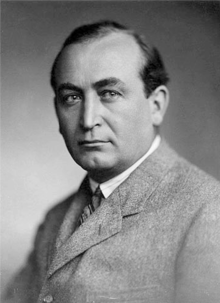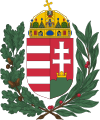Gyula Gömbös
Vitéz Gyula Gömbös de Jákfa | |
|---|---|
 | |
| Prime Minister of the Kingdom of Hungary | |
| In office 1 October 1932 – 6 October 1936 (4 years, 5 days) | |
| Preceded by | Gyula Károlyi |
| Succeeded by | Kálmán Darányi |
| Personal details | |
| Born | 26 December 1886 Murga, Austria-Hungary |
| Died | 6 October 1936 (aged 49) Munich, Germany |
| Political party | National Smallholders and Agrarian Workers' Party (1920–1922) Unity Party (1922–1924) Hungarian National Independence Party (1924–1928) Unity Party → Party of National Unity (1928–1936) |
| Spouse(s) | Greta Reichert (first) Erzsébet Szilágyi (second) Greta Reichert (third; again) |
Gyula Gömbös de Jákfa (26 December 1886 – 6 October 1936) was the conservative prime minister of Hungary from 1932 to 1936.
Background
Gömbös was born in the Tolna County village of Murga, Hungary, which had a mixed Hungarian and ethnic German population. His father was the village schoolmaster. The family belonged to the Hungarian Evangelical (i. e. Lutheran) Church.[1]
Gömbös entered the Austro-Hungarian Army as a cadet in Pécs and quickly became a member of the officer corps, serving as a captain during World War I. While in the army, Gömbös became a staunch advocate of Hungary's gaining independence from Austria and a bitter critic of the Habsburgs. After World War I ended and Hungary split from Austria, Gömbös joined Conservative Hungarian forces in Szeged that were unwilling to support Communist Béla Kun, who had seized control of Hungary in 1919, forming his own paramilitary group, the Hungarian National Defence Association (Magyar Országos Véderő Egylet, or MOVE). Gömbös became a close ally of Miklós Horthy, the leader of the anti-Communist government in Szeged, and played a leading role in organizing Horthy’s army. For his services, Gömbös was made minister of defense in the Szeged government. After Kun’s government was ousted in August 1919, Gömbös helped direct the Conservatives’ purge of Communists from Hungarian society. Gömbös also supported the actions against Hungary’s Jews, who Gömbös and his colleagues believed were the primary backers of Communism, having noted that Kun and many of the ministers in his Communist government were Jews.
Rightward
After Horthy was made regent of Hungary in 1920, Gömbös became the primary leader of Hungary’s emerging Conservative political movement, which was gaining some support from the nation’s people as a response to the Communists’ rule and the signing of the Treaty of Trianon, which resulted in Hungary losing two-thirds of its territory to neighboring nations. Despite some disagreements with the military leader and regent Miklós Horthy, Gömbös was active in the White Terror and later organized mass military opposition to the Habsburg pretender Charles IV's plan to regain his throne in 1921, a move which kept Horthy firmly in control of Hungary. Later that year, Gömbös became one of the primary leaders of the political opposition against Conservative István Bethlen, when Bethlen became prime minister of Hungary. During the 1920s, Gömbös was a major advocate of making Hungary a one-party state and reorganizing the country along totalitarian lines, implementing land reform, creating anti-Jewish laws, and withdrawing Hungary from the League of Nations. In 1929, Gömbös was made a major general and appointed Minister of Defense in the Bethlen government by Horthy in an attempt to appease the growing Right, but Gömbös’s ambition was not abated.
Prime minister
By 1932, the Right had become such a force in Hungary that Horthy had no choice but to appoint Gömbös prime minister. However, Horthy forced Gömbös to recant his anti-Semitism and to agree not to dissolve the current Parliament and call for new elections. This severely limited Gömbös’s ability to bring about the kind of sweeping domestic changes he had in mind, as Parliament was packed with Conservative Bethlen supporters. However, Gömbös never gave up his plans for making Hungary a fascist state, and subsequently used what power he had and the backing of the secret police to establish a much more authoritarian government than those of his predecessors.

While prime minister, Gömbös was very active in international politics. One of his major goals was to align Hungary into an Axis with Italy and Austria. Shortly after becoming prime minister, Gömbös flew to Italy and visited Benito Mussolini. The two came to an accord, and Mussolini gave Gömbös his support for the revision of the Treaty of Trianon. Mussolini also promised Gömbös Italy’s aid if Hungary went to war with Yugoslavia and Romania in an attempt to regain Hungary’s former territory from those nations. However, Gömbös also harbored hopes of forming an alliance with Germany, especially when it seemed that the Nazi Party would gain control of the country. When Adolf Hitler became Chancellor of Germany in 1933, Gömbös became the first head of a foreign nation to visit the Nazi leader. Shortly thereafter, Gömbös signed a major trade agreement with Germany which would greatly improve Hungary’s ailing economy as the 1930s progressed. The move alarmed many Hungarian political leaders, who believed Gömbös’s relations with Germany would damage Hungary’s ties with Italy, as Italy and Germany were in dispute over a proposed union between Germany and Austria. Gömbös eventually decided to align Hungary primarily with Italy and Austria when Hitler made it clear to Gömbös that while he would support Hungary in an effort to regain land from Czechoslovakia, he would not support Hungary against Romania or Yugoslavia. Hitler was also against Gömbös’s plans to expand the size and power of the Hungarian military, while Mussolini supported the idea.
In early 1935, Gömbös’s luck greatly improved when he convinced Horthy to dissolve the Parliament and hold new elections. The elections resulted in Hungary’s right wing assuming control of the Parliament, which in turn led to a huge increase in Gömbös’s power. Gömbös expanded and re-equipped the army, filled it with sympathetic officers, and exerted greater control over the civil services by filling them with supporters. In 1936, Gömbös boasted to Hermann Göring that within two years, Hungary would be completely remodeled along fascist lines with himself serving as dictator.
Death in office
However, Gömbös never lived to see his ambitious plans come to fruition. Gömbös, after a long illness, died of testicular cancer in Munich on 6 October 1936.[2]
See also
References
- ^ Retrieved 8 March 2011.
- ^ Earlier accounts had kidney failure as the cause of death. See Püski, Levente: A Horthy-rendszer (The Horthy System; Budapest: Pannonica, 2006), pp. 104-6.
Further reading
- Kürti, László (2006). "Gömbös, Gyula". In Blamires, Cyprian (ed.). World fascism: a historical encyclopedia. Vol. 1. Santa Barbara, California: ABC-CLIO. pp. 285–286. ISBN 1-57607-940-6.
External links
- A Gömbös-kormányról „A háború árnyékában”, Szegedi Egyetemi Könyvtár
- Gömbös Gyula Gergely Jenő írása (mult-kor.hu)
- Az evangélikus Gömbös Gyula
- Use dmy dates from December 2010
- 1886 births
- 1936 deaths
- Antisemitism in Hungary
- Deaths from testicular cancer
- Cancer deaths in Germany
- People from Tolna County
- Prime Ministers of Hungary
- Defence ministers of Hungary
- Foreign ministers of Hungary
- Recipients of the Order of the White Eagle (Poland)
- Hungarian anti-communists
- Hungarian fascists
- Hungarian Nazis


